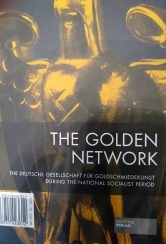Chapter extracts from: The Golden Network – The Deutsche Gesellschaft für Goldschmiedekunst During the National Socialist Period
© 2019 Societäts-Verlag, Frankfurt, authors, translator. ISBN: 978-3-95542-361-2 
In October 1922, on account of the rising inflation rates, Wilm had founded, with the support of the State Secretary at the Reichsfinanzministerium (Reich Financial Ministry), Dr. Peters, the Gold-Kredit Aktiengesellschaft, whose members were now only to complete their transactions and financing projects in gold instead of using paper money. As a result of this, everyday transactions remained possible and Wilm was able to bypass the inflation that posed a major problem to other businesses. However, Wilm achieved even more than that: in the midst of hyperinflation, he founded the Goldschmiedehaus (German Goldsmith’s House) in Berlin, a not-for-profit institution comprising exhibition spaces, a library, an archive, and lecture halls that was to be used to promote handcrafted gold and silver design. As a trained banker, Wilm deftly exploited the inflation that prevailed. On behalf of the Reichsverband Deutscher Juweliere he took out a loan to finance the German Goldsmith’s House, which he secured with gold. The hyperinflation meant that the loan he had taken up became cheaper and the debt could be swiftly paid off in the wake of the currency reform. In 1925, together with Carel Begeer, Ferdinand R. Wilm founded an international company, “Bureau International de la Bijouterie Orfèverie et Argenterie (B.I.B.O.A.)”, with its head office in Den Haag, which organized conferences for silver manufacturers and jewelers. The experience garnered along the way, and his growing network, had certainly also benefited Wilm when he founded the Deutsche Gesellschaft für Goldschmiedekunst.
Click on the poppy for a look at the objectives of the DGfGK:![]()
